Portal:Physics/2007 Selected pictures
| This is an archive of past discussions about Portal:Physics. Do not edit the contents of this page. If you wish to start a new discussion or revive an old one, please do so on the current main page. |
This is an archive of entries that have appeared or will appear on Portal:Physics's Selected picture section in 2007.
Week 1

The incandescent metal embers of the spark used to light this Bunsen burner emit light ranging in color from white to orange to red. This change correlates with their temperature as they cool in the air. Note that the flame itself is luminescent (not incandescent) as its blue color is due to various other atomic and molecular energy transitions.
Week 2
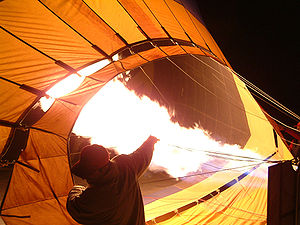
Raising the air temperature inside the envelope of a hot air balloon makes it lighter than the surrounding (ambient) air. The rising hot air exerts pressure on the upper hemisphere of the balloon to provide lift, making the balloon capable of flight.
Week 3
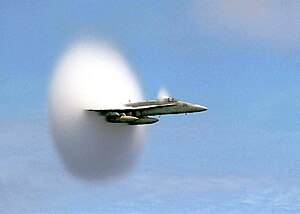
The Prandtl–Glauert singularity, the point at which a sudden drop in air pressure occurs, is generally accepted as the cause of the visible condensation cloud that often surrounds an aircraft traveling at transonic speeds, though there remains some debate. It is an example of a mathematical singularity in aerodynamics.
Week 4

Plasma lamps are a type of electrodeless gas-discharge lamp energized by radio frequency (RF) power. They are distinct from the novelty plasma lamps that were popular in the 1980s.
The internal-electrodeless lamp was invented by Nikola Tesla after his experimentation with high-frequency currents in evacuated glass tubes for the purposes of lighting and the study of high voltage phenomena. The first practical plasma lamps were the sulfur lamps manufactured by Fusion Lighting. This lamp suffered several practical problems and did not prosper commercially. Plasma lamps with an internal phosphor coating are called external electrode fluorescent lamps (EEFL); these external electrodes or terminal conductors provide the radio frequency electric field. (Full article...)
Week 5

The Teller–Ulam design is a nuclear weapon design which is used in megaton-range thermonuclear weapons, and is more colloquially referred to as "the secret of the hydrogen bomb". This diagram depicts the basics of the Teller–Ulam configuration: a fission bomb uses radiation (from the bottom section) to compress and heat a separate section of fusion fuel (the top section).
Week 6

Piccard, Henriot, Ehrenfest, Herzen, De Donder, Schrödinger, Verschaffelt, Pauli, Heisenberg, Fowler, Brillouin,
P. Debye, M. Knudsen, W.L. Bragg, Kramers, Dirac, Compton, de Broglie, Born, Bohr,
Week 7

Views of spacetime along the world line of a rapidly accelerating observer (see Lorentz transformation).
Vertical direction indicates time. Horizontal indicates distance, the dashed line is the spacetime trajectory ("world line") of the observer. The lower quarter of the diagram shows the events visible to the observer. Upper quarter shows the light cone- those that will be able to see the observer. The small dots are arbitrary events in spacetime.
The slope of the world line (deviation from being vertical) gives the relative velocity to the observer. Note how the view of spacetime changes when the observer accelerates.
Week 8
Halos are optical phenomena that appear near or around the Sun or Moon, and sometimes near other strong light sources such as street lights. There are many types of optical halos, but they are mostly caused by ice crystals in cold cirrus clouds located high (5–10 km, or 3–6 miles) in the upper troposphere. The particular shape and orientation of the crystals is responsible for the type of halo observed. Light is reflected and refracted by the ice crystals and may split up into colors because of dispersion, similarly to the rainbow.
Week 9
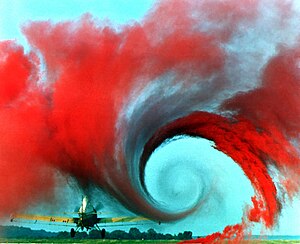
Wake turbulence is turbulence that forms behind an aircraft as it passes through the air. This turbulence includes various components, the most important of which are wingtip vortices and jetwash. Jetwash refers simply to the rapidly moving air expelled from a jet engine; it is extremely turbulent, but of short duration. Wingtip vortices, on the other hand, are much more stable and can remain in the air for up to two minutes after the passage of an aircraft. Wingtip vortices make up the primary and most dangerous component of wake turbulence.
Week 10

Arc welding uses a welding power supply to create an electric arc between an electrode and the base material to melt the metals at the welding point. They can use either direct (DC) or alternating (AC) current, and consumable or non-consumable electrodes. The welding region is sometimes protected by some type of inert or semi-inert gas, known as a shielding gas, and/or an evaporating filler material. The process of arc welding is widely used because of its low capital and running costs.
Week 11

Aerogel is a low-density solid-state material derived from gels in which the liquid component of the gel has been replaced with gas. The result is an extremely low density solid with several remarkable properties, most notably its effectiveness as an insulator. It is nicknamed frozen smoke, solid smoke or blue smoke due to its semi-transparent nature and the way light scatters in the material; however, it feels like extruded polystyrene to the touch.
Week 13

The "energy flash" of a hypervelocity impact during a laboratory simulation of what happens when a piece of orbital debris hits a spacecraft in orbit.
Week 14

Cutaway rendering of a cathode ray tube (see legend). The CRT was invented by Karl Ferdinand Braun, based on work by Philo Farnsworth, and was the display device that was traditionally used in most computer displays, video monitors, televisions, radar displays and oscilloscopes until the late 20th century before the advent of plasma screens, LCD TVs, DLP, OLED displays, and other technologies.
Week 15

A rope trick is the whimsical term given by physicist Dr. John Malik to the curious lines and spikes which emanate from the fireball of a nuclear explosion just after detonation. The image is from the Tumbler-Snapper test series of 1952.
The surface of the fireball is over 20,000 kelvins and emits huge amounts of visible light radiation. The 'rope tricks' which protrude from the bottom of the fireball are caused by the heating, rapid vaporization and then expansion of the mooring cables tethering the tower supporting the nuclear bomb at the start of the test.
Week 17

A thunderstorm, also called an electrical storm, is a form of weather characterized by the presence of lightning and its attendant thunder produced from a cumulonimbus cloud. Thunderstorms are usually accompanied by heavy rainfall and they can also be accompanied by strong winds, hail and tornadoes. In the winter months, snowfall can occasionally take place in a thunderstorm. Such is often termed thundersnow.
Thunderstorms form when significant condensation—resulting in the production of a wide range of water droplets and ice crystals—occurs in an atmosphere that is unstable and supports deep, rapid upward motion. This often occurs in the presence of three conditions: sufficient moisture accumulated in the lower atmosphere, reflected by high temperatures; a significant fall in air temperature with increasing height, known as a steep adiabatic lapse rate; and a force such as mechanical convergence along a cold front to focus the lift. The process to initiate vertical lifting can be caused by (1) unequal warming of the surface of the Earth, (2) orographic lifting due to topographic obstruction of air flow, and (3) dynamic lifting because of the presence of a frontal zone.
May

The locations of Voyager 1 and Voyager 2 as of 2005. The termination shock is the boundary marking one of the outer limits of the sun's influence. It is where the bubble of solar wind particles slows down to subsonic speed (with respect to the star) due to interactions with the local interstellar medium. This causes compression, heating, and a change in the magnetic field. Beyond this is the heliosheath, which ends at the heliopause - the boundary where the Sun's solar wind is stopped by the interstellar medium. This is not spherical as the sun is moving around the center of the galaxy; in this image, it is moving to the left. This sets up a bow shock in the interstellar medium.
June

Crepuscular rays, in atmospheric optics, also known as sun rays or God's rays, are rays of sunlight that appear to radiate from a single point in the sky. These rays, which stream through gaps in clouds, are diverging columns of sunlit air separated by darker cloud-shadowed regions. The name comes from their frequent occurrences during twilight, when the contrasts between light and dark are the most obvious. Various airborne compounds scatter the sunlight and make these rays visible. The reason we see the light so defined is because of diffraction, reflection and scattering.
July
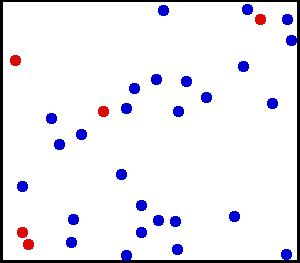
The translational motion of fundamental particles of nature such as atoms and molecules gives a substance its temperature. Here, the size of helium atoms relative to their spacing is shown to scale under 1950 atmospheres of pressure. These room-temperature atoms have a certain average speed (slowed down here two trillion fold). At any given instant however, a particular helium atom may be moving much faster than average while another may be nearly motionless. Five atoms are colored red to facilitate following their motions.
August

A ferrofluid is a liquid which becomes strongly polarised in the presence of a magnetic field. Ferrofluids are composed of nanoscale ferromagnetic particles suspended in a carrier fluid, usually an organic solvent or water. The ferromagnetic nano-particles are coated with a surfactant to prevent their agglomeration (due to van der Waals and magnetic forces). Although the name may suggest otherwise, ferrofluids do not display ferromagnetism, since they do not retain magnetisation in the absence of an externally applied field. In fact, ferrofluids display paramagnetism, and are often referred as being "superparamagnetic" due to their large magnetic susceptibility. True ferromagnetic fluids are difficult to create at present.
September

An animated cut away diagram of a typical fuel injector. Fuel injectors are used to spray controlled amounts fuel into an internal combustion engine. A solenoid is activated when fuel is intended to be delivered to the engine causing the plunger to become pulled toward the solenoid by magnetic force. This uncovers the valve opening allowing fuel to flow into the atomiser and out the spray tip as it is under pressure. A valve spring attached to the plunger returns the plunger to its original position when the solenoid is switched off. The route of fuel is shown in orange, grey/blue indicates no fuel present.
October
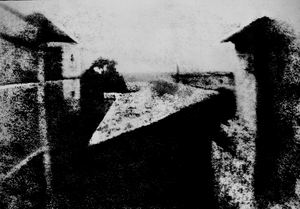
Nicéphore Niépce began experimenting with processes to set optical images in 1793. Some of his early experiments produced images, but they faded rapidly. He was said to have first produced long lasting images in 1824. The earliest known surviving example of a Niépce photograph (or any other photograph) was created around 1826 (shown above). Niépce called his process "heliography", meaning "sun writing".
November

Plasma is the state of matter that consists of ionized gas. It is the most common state of matter, making up almost 99% of the visible matter in the universe. The term "plasma" was first used in the 1920s by physicist Irving Langmuir.
December

The asteroid 243 Ida and its 0.7 km moon Dactyl of the Asteroid belt as seen by the Galileo spacecraft before its approach. The slight color variations of the asteroid's surface are due to differences in surface composition (and differences in lighting).
